WHEN YOU GROW UP IN THE FLORIDA KEYS, the Atlantic Ocean is your backyard and the Gulf of Mexico is the front — or as the locals say, the ocean and the bay. Fins are your enclosed footwear, and your mask and snorkel dangle from your elbow after school or on weekends. You never know when you’ll need to jump in the water and explore. After all, the land and the sea are seamless, and if you’re lucky you own a boat before you’re old enough to drive a car.
To a Keys kid, freediving is like walking. It got you from point A to point B, and you learned it by observing your parents and friends who were good at it and then winging it from there. The goal was simple: Learn to hold your breath for as long as possible to catch the most lobster, spear the most fish, or capture the most footage on your waterproof disposable camera. Aside from following dive flag protocol, diving with a buddy, and observing your natural cues to equalize and surface for air, freediving was unencumbered. Soaring through the water with minimal gear felt outside the confines of precautions — until it wasn’t.
A SHAKEN COMMUNITY
In 2004 a Keys kid named Nick passed away at age 16 from a shallow-water blackout (SWB) during a dive accident in the Bahamas. While I didn’t personally know Nick and was at college in Gainesville, Florida, at the time, my twin younger brothers were close friends with him. Nick’s death rocked our family and the entire Upper Keys community because of the loss of such a wonderful person. It made locals pause and consider their safety practices (or lack thereof) when freediving.
Nick’s death was also the first time I’d learned of SWB, which is essentially an underwater faint caused by a lack of oxygen in the brain that occurs in less than 15 feet of water. You can prevent SWB with a proper understanding of the gas exchange in the body while underwater and the appropriate surface breathing technique to avoid hyperventilation, which artificially lowers carbon dioxide levels just before descent. That knowledge and other safety-oriented freediving processes make a freediving certification worthwhile for anyone who does underwater activities.
Capps (left) and Cornell (right) share the line during the constant-weight dive portion of the open-water session.
THERE’S A CERT
FOR THAT?
I moved to Southern California in 2004 and since then have limited my scuba diving and freediving to trips home to the Keys. I’m used to Florida’s warm, clear waters and am not acclimated to the cooler SoCal dive environment. But I’ve recently had the itch to freedive and spearfish in SoCal with some friends who do both in the summer and close to shore. One of these friends suggested that I explore getting my freediving certification to help with my calmness, confidence, and safety during breath holds in the mighty and often unpredictable waves of Venice Beach, California. So I decided to squeeze in a freediving certification while visiting home and the more familiar Key Largo waters.
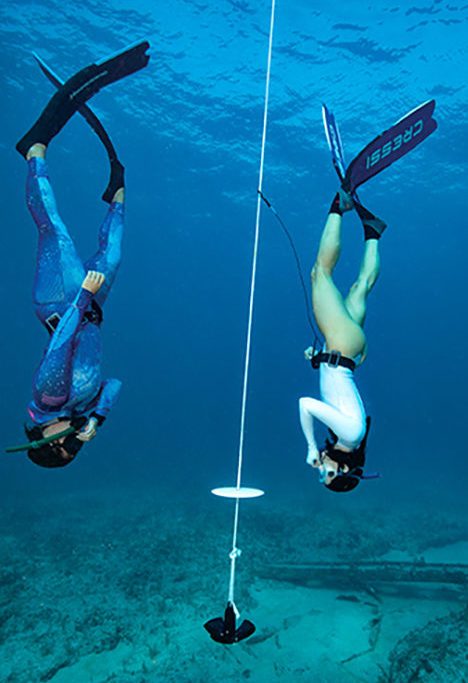
Finding a freediving instructor in the Keys was difficult, as so many people freedive but few with proper training. I was fortunate to find Anna Capps with Amoray Dive Resort in Key Largo as an instructor under the guidance of fellow freediving instructor Ed Martin of Killshot Spearfishing. Like most dive certifications, I had an e-learning or classroom portion before going to the Keys for the pool portion, followed by another day for the open-water portion, weather permitting. While the format was familiar, I soon discovered that I was not prepared for all I was about to experience.
VIRTUAL LEARNING
As I read through the text and watched the e-learning videos, I felt an overwhelming sense of anxiety building. Rather than the obvious reminder of my own risk involved in freediving, my anxiety came from learning a lot very quickly about an activity I’d done for so long.
Until then I was unaware of the likelihood of a loss of motor control (LMC) or an SWB. I didn’t have a thorough knowledge of their causes or an understanding of the proper methods to prepare for and execute a dive that would significantly decrease the odds of either happening. But most important, I thought of my family and loved ones who also hadn’t been certified and were freediving frequently. I stopped my coursework to call them and urge them to join me in obtaining freediving certifications.
Before starting the coursework, I thought the freediving certification would simply teach me how to hold my breath for an impressive amount of time. But it was so much more than that, providing an invaluable lesson in the chemistry of gas exchanges that we experience when submerging underwater and the mammalian dive response to these environmental changes as a means of survival. I also greatly underestimated the safety training I would learn during the course.
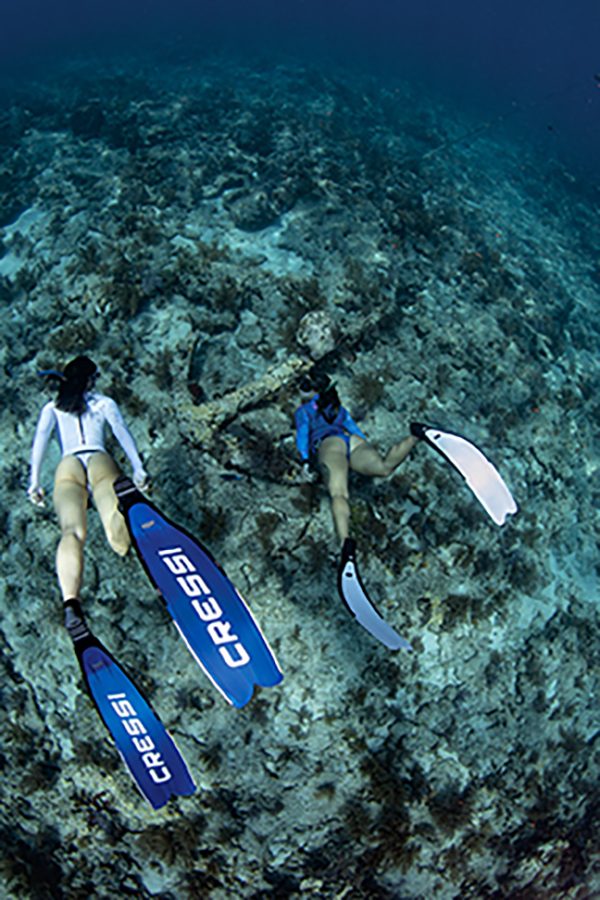
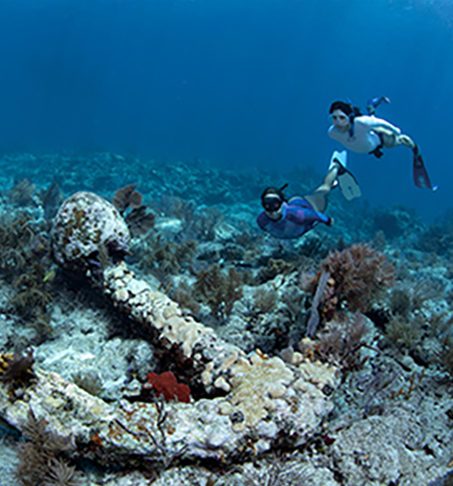
Capps and Cornell glide past the Spanish Anchor, a dive site at Molasses Reef in Key Largo.
Instructor Anna Capps and freediving student Lauren Cornell enjoy a free immersion dive together after completing the certification requirements.
THE CONFINED-WATER SESSION
If you’ve completed any dive certification, you expect to start in a pool for the confined atmosphere away from the elements. But in a freediving course you are practicing your freediving safety protocols in a setting with the same potential as open water since SWB can also happen in a pool. Anna was patient and passionate about the sport, and as a freediver and scuba diver, she felt strongly about the certification’s safety aspect.
Using what I had learned online was a spiritual experience. Being in the water led to a comprehensive lesson in understanding my own body’s cues for survival and how to relax properly.
During the static apnea exercise, Anna coached me through full relaxation as I completed my breath-hold requirements. Her gentle verbal cues made me aware of the tension that I was holding in my shoulders, limbs, and even my mind. I also wasn’t aware of how much strain the mind creates by attempting to relax. Unlike scuba, you don’t even have the repetitive sound of breathing to focus on — just pure silence, which allowed me to concentrate on my body and discern its signals. Those two objectives result in confidence and trust in yourself, essential aspects of protection.
THE OPEN-WATER SESSION
I completed my open-water training nearly two months after my confined-water session due to weather constraints, yet I found that I could quickly recall the lessons in breath-hold techniques and the static and dynamic apnea training in the pool. Over two dive locations — the Benwood shipwreck and Molasses Reef in Key Largo — we found the depth we needed against some of the most spectacular scenery the Upper Keys has to offer.
We completed the certification requirements for a free immersion and a constant-weight freedive to at least 30 feet while practicing proper buddy procedures for various rescue techniques. Since most of the instruction happens on the surface, you pray for calm seas and cooperative weather, and the day went beyond, featuring the best conditions I’ve ever witnessed on the Keys reefs. We had a tiny smattering of 1-foot seas at our spot 5 miles offshore, and visibility was more than 100 feet at both locations.
Even with optimal conditions, there were distractions during the session — mask sounds while equalizing, bubbles from nearby scuba divers, and the intense physical compression as you descend and ascend without the pressure relief provided by breathing gas. During all that, you have to remember the order of all the steps to complete a successful freedive and your certification.
The silent world instead buzzed with thoughts and sounds. As a result, my first freedive attempt ended prematurely. I quickly found solace in my next breathe-up, which allowed me to regroup, find peace, and trust in my knowledge base.
With a weighted line, you can fully tuck your chin, turning the underwater world completely upside down. It might sound disorienting and stressful, but following the line’s visual guidance is quite soothing. Tucking your chin helps expand your mouth and throat to hold more air and extend your oxygen reserves. The other key to extending your breath-hold time is learning to relax, which I could do with the help of the rhythm I formed from breathing, line pulls, and equalizing during the free immersion and kicking during the constant-weight dive. A successful freedive is rooted in the three Rs: relaxation, rhythm, and relinquishing control to gravity.
The freediving experience is one of zooming in to focus on the minutiae of technique and safety procedures while simultaneously zooming out to trust in the primal human instincts and the natural laws of physics. It is a physical and mental test of pushing your boundaries as much as releasing your grip on control. When you can blend the two, you realize your body’s potential while understanding its limits from a safe distance, all while enjoying a fascinating sport that opens up a world of opportunities. AD
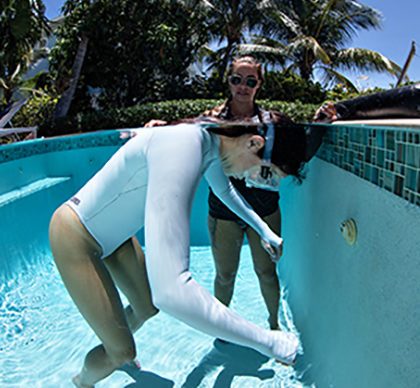
Capps coaches Cornell to fully relax during her static apnea exercise in the confined-water session.
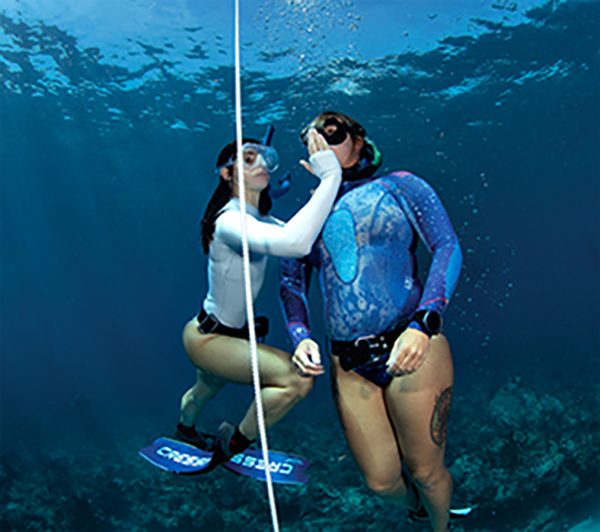
Cornell demonstrates her SWB rescue technique on Capps.
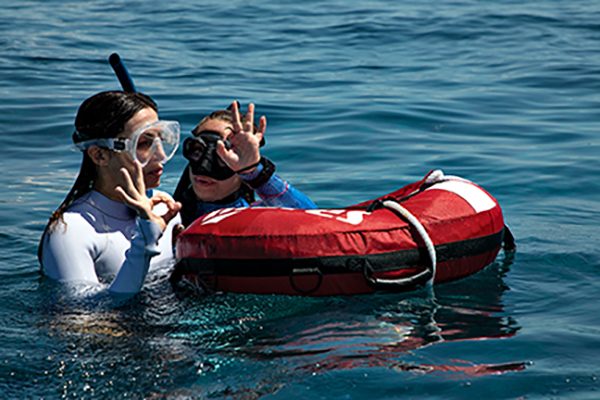
Capps and Cornell signal that all’s well after completing their recovery breathing at the surface.
© Alert Diver - Q3 2022